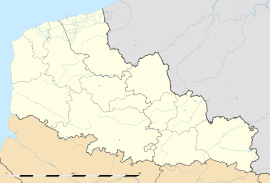Sailly-sur-la-Lys
| Sailly-sur-la-Lys | |
|---|---|
 Sailly-sur-la-Lys | |
|
Location within Nord-Pas-de-Calais region  Sailly-sur-la-Lys | |
| Coordinates: 50°39′30″N 2°46′15″E / 50.6583°N 2.7708°ECoordinates: 50°39′30″N 2°46′15″E / 50.6583°N 2.7708°E | |
| Country | France |
| Region | Nord-Pas-de-Calais |
| Department | Pas-de-Calais |
| Arrondissement | Béthune |
| Canton | Laventie |
| Intercommunality | Monts de Flandre–Plaine de la Lys |
| Government | |
| • Mayor (2008–2014) | Annie Van Cortenbosch |
| Area | |
| • Land1 | 9.7 km2 (3.7 sq mi) |
| Population (2006) | |
| • Population2 | 4,108 |
| • Population2 Density | 420/km2 (1,100/sq mi) |
| INSEE/Postal code | 62736 / 62840 |
| Elevation |
13–19 m (43–62 ft) (avg. 17 m or 56 ft) |
|
1 French Land Register data, which excludes lakes, ponds, glaciers > 1 km² (0.386 sq mi or 247 acres) and river estuaries. 2 Population without double counting: residents of multiple communes (e.g., students and military personnel) only counted once. | |
Sailly-sur-la-Lys is a commune in the Pas-de-Calais department in the Nord-Pas-de-Calais region of France.
Geography
Sailly-sur-la-Lys is a large farming and light industrial village situated some 3 miles (4.8 km) southeast of Béthune and 24 miles (38.6 km) southwest of Lille, at the junction of the D945 and D66 roads. The Lys River forms much of the western and northern boundary of the commune.
Population
| Year | 1962 | 1968 | 1975 | 1982 | 1990 | 1999 | 2006 |
|---|---|---|---|---|---|---|---|
| Population | 1789 | 1924 | 2049 | 2919 | 3889 | 3981 | 4108 |
| From the year 1962 on: No double counting—residents of multiple communes (e.g. students and military personnel) are counted only once. | |||||||
Places of interest
- The church of St. Vaast, rebuilt, along with most of the village, after the First World War.
- The Commonwealth War Graves Commission cemetery.
- The sixteenth century prévoté. English: provost’s house.
The prévôté is a fortified building located by the parish cemetery, near the Lys. It includes the remains of the prison and the courts of justice. A chapel dedicated to the Virgin complements the construction. The gateway, which was destroyed in the sixteenth century and rebuilt in 1612, is defended by two towers with mullioned windows. Before the French Revolution, it was the provost himself that represented the abbot (of Saint-Vaast) in all matters civil and judicial.
See also
References
External links
- Official commune website
- Official website of Sailly sur la Lys' social club
- The CWGC Canadian cemetery
- The CWGC graves in the churchyard
- Sailly-sur-la-Lys on the Quid website (French)